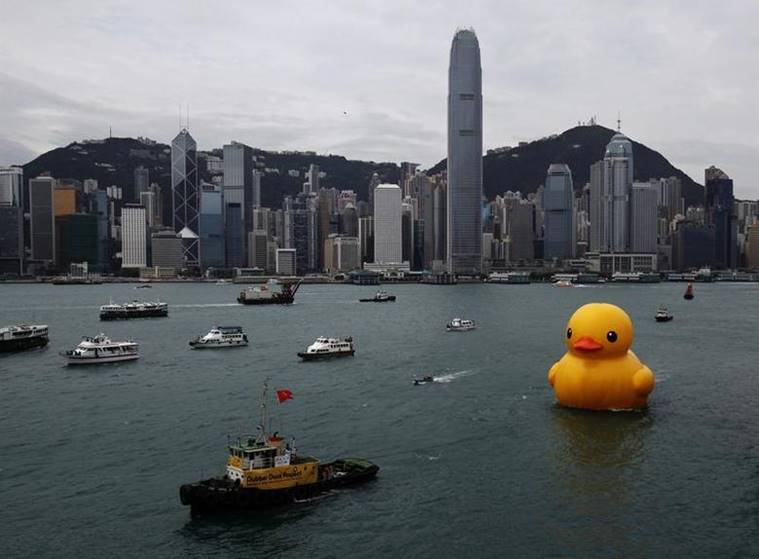These yellow rubber ducks had first made an appearance on Tuesday this past week, when protesters had gathered outside the police headquarters in Bangkok, on what was the day of the most violent of demonstrations.
Since protests started in Thailand in July this year, seeking the removal of Prime Minister Prayuth Chan-ocha and demanding reform of the Thai monarchy, the movement has seen protesters adopt different mascots to get their message across; everything from singing the Thai version of one of the 1980s musical Les Misérables’ principal songs “Do You Hear the People Sing?” to dinosaur costumes to displaying the three-finger salute.
The latest addition to this compendium is the use of large inflatable pool ducks. But over the past week, these inflatable ducks have become more than just a mascot at the protests.
Why are protesters using inflatable ducks?
News reports quote protesters saying that these inflatable ducks had initially been brought out onto the streets as a joke, while some protestors have told news publications that the rubber ducks were used to mock the government and the monarchy.
But they took on a new role as the Thai government’s crackdown on the protests intensified. According to a Reuters report, these yellow rubber ducks had first made an appearance on Tuesday this past week, when protesters had gathered outside the police headquarters in Bangkok, on what was the day of the most violent of demonstrations.
The protestors had used these ducks as shields and advanced towards police lines when police forces began firing water cannons. In recent photographs and videos from the protests, protesters can be seen carrying large yellow plastic ducks hovering above the crowds.
What are these yellow inflatable ducks?
Observers say that this yellow inflatable rubber duck has been inspired by Dutch artist Florentijn Hofman’s series of floating sculptures titled ‘Rubber Duck’ that has been exhibited in several cities around the world, including Hong Kong, Baku and Sydney.
But a few weeks after it was installed in Hong Kong’s Victoria Harbour in May 2013, China’s government began imposing censorship on online discussions of the term “Big Yellow Duck” after activists started photoshopping images of the duck into the iconic photo of the Tank Man from the 1989 Tiananmen Square Protests. Since then, this yellow duck has become an unusual symbol of protests around the world. ? Click to follow Express Explained on Telegram
Where else have these ducks surfaced in protests?
In 2016, groups that were calling for the impeachment of Brazil’s President Dilma Rousseff began using the rubber duck as a mascot. But at that time, Hofman, the artist, had claimed that the use of the figure by these protest groups amounted to copyright infringement.
Versions of these rubber ducks were seen during the 2017-2018 anti-corruption protests in Russia, where among other demands, protestors called for the resignation of Vladimir Putin and his government.
The ducks also surfaced during protests last year in Hong Kong, where protesters confronted police and were photographed carrying these small plastic ducks. One iconic image from these protests in Hong Kong shows a battalion of police standing on one side of a road with a small yellow rubber duck placed on the ground in front.
What happened in Thailand?
Social media platforms were flooded with images of these inflatable rubber ducks from this week’s protests in Thailand. Several of these images show deflated rubber ducks stained with purple dye that protesters said had been projected from water cannons launched by Thai police.
Thailand’s youth quickly turned the yellow rubber duck into a symbol of the protest movement by creating related artwork available for purchase online. One poster shows the rubber duck as a shirtless muscular man, protecting young protesters from a hail of bullets, presumably fired by Thai police. Hong Kong activist Joshua Wong who has been a vocal supporter of Thai protesters had tweeted “Creativity wins. Long live rubber ducks.”
Thai social media users around the world have also taken to various platforms to share content related to the protests using the hashtag #RubberDuck and other related hashtags that have been used since the protests started earlier this year.
Source: Read Full Article





